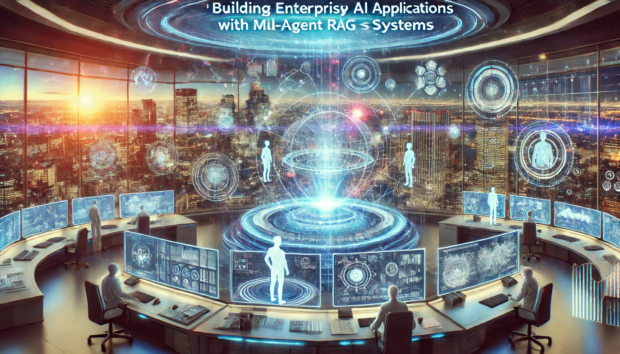In the rapidly evolving world of artificial intelligence, the emergence of advanced Retrieval-Augmented Generation (RAG) and Multi-Agent Software Engineering (MASE) has opened new horizons for enterprise AI applications. Let’s explore how these technologies converge to create a powerful tool for businesses.
What is an AI Agent?
An AI agent is an autonomous entity capable of reasoning, acting, and possessing memory. A typical agent consists of three key elements:
- Intelligence: Access to Large Language Models (LLMs)
- Knowledge: Repository of structured and unstructured data
- Receptors and Effectors: Tools and APIs for perceiving the environment and executing tasks
A simple agent might include an Anthropic LLM for intelligence, exa-search and retriever tools (connected to SingleStore) for access and knowledge.
The Evolution of RAG in Enterprises
The simple approach to RAG, often referred to as “naive RAG,” proved insufficient for the complex needs of large enterprises. The main challenges companies faced were:
- Accuracy: Zero tolerance for AI hallucinations, especially critical in finance and healthcare
- Relevance: The need for precise extraction of only necessary information for efficient resource use
- Latency: Requirement for lightning-fast RAG system operation, completing tasks in less than a second
Achieving Precision and Speed
To address these challenges, the following approaches are proposed:
- Accuracy:
- Fine-tuning embedding models and LLMs
- Effective evaluation methods
- Function calling for structured data
- Real-time monitoring with feedback (RLHF)
- Relevance:
- Integration of data from various sources (data lakes, warehouses, lakehouses)
- Use of real-time, up-to-date information
- Latency:
- Architecture optimization for sub-second response
Technology Stack for MARS
- Embedding Creation: Nvidia Inference Microservices (NIMs) – allows calling Nvidia APIs or using your own H100s
- Semantic Caching: SingleStore – a unified platform for all data requirements
- Data Retrieval: Combination of semantic and keyword search using SingleStore
- Security: Nvidia Nemo Guardrails – for input/output validation, PII masking, etc.
- Evaluation: RAGAs library
Multi-Agent RAG Systems (MARS)
Instead of a monolithic architecture, a multi-agent approach is proposed:
- Specialized agents for individual tasks
- Parallel execution of operations
- Optimized resource usage
- Increased efficiency and accuracy
Advantages of MARS:
- Maintainability: Ability to independently update and replace tools
- Parallelism: Agents can work simultaneously on different GPUs or computing resources
- Resource Optimization: Workload distribution between GPUs and CPUs
- Efficiency and Accuracy: Task isolation facilitates debugging and iterative evaluation with RLHF
Additional Agents
- Query Planning Agent: Develops the best approach to answering queries
- Context Enrichment Agent: Supplements extracted information with additional context
- Response Generation Agent: Forms the final response based on enriched information
- Feedback Integration Agent: Processes user feedback to improve the system
- Logging and Monitoring Agent: Manages comprehensive logging and real-time monitoring
- Data Versioning Agent: Controls versions of data, embeddings, and model artifacts for reproducibility
System Orchestration
For orchestrating the multi-agent RAG system, the LangGraph framework is recommended, providing flexibility, scalability, and integration with other tools.
Implementation Example
Here’s an expanded example of how to implement a simple multi-agent system using LangGraph:
from langchain import OpenAI, SQLDatabase, SQLDatabaseChain
from langchain.agents import initialize_agent, Tool
from langchain.chains import LLMChain
from langchain.prompts import PromptTemplate
from langgraph.graph import StateGraph, AgentState
# Initialize LLM and database
llm = OpenAI(temperature=0)
db = SQLDatabase.from_uri("your_database_uri")
# Agent for SQL code generation
sql_generation_prompt = PromptTemplate(
input_variables=["schema", "question"],
template="Given the following SQL schema:\n{schema}\n\nGenerate a SQL query to answer the question: {question}"
)
sql_generation_chain = LLMChain(llm=llm, prompt=sql_generation_prompt)
def generate_sql(question):
schema = db.get_table_info()
return sql_generation_chain.run(schema=schema, question=question)
sql_generation_tool = Tool(
name="SQL Generation",
func=generate_sql,
description="Generate SQL code based on the given question and database schema."
)
# SQL generation agent
sql_agent = initialize_agent(
[sql_generation_tool],
llm,
agent="zero-shot-react-description",
verbose=True
)
# Agent for SQL execution and data enrichment
def execute_sql(query):
return db.run(query)
sql_execution_tool = Tool(
name="SQL Execution",
func=execute_sql,
description="Execute the given SQL query and return the results."
)
enrichment_agent = initialize_agent(
[sql_execution_tool],
llm,
agent="zero-shot-react-description",
verbose=True
)
# Create workflow with graph, nodes, and edges
workflow = StateGraph(AgentState)
# Add nodes for agents
workflow.add_node("sql_generation_agent", sql_agent)
workflow.add_node("sql_execution_agent", enrichment_agent)
# Define workflow
@workflow.run
def execute_workflow(query: str):
sql_query = workflow.nodes.sql_generation_agent(query)
result = workflow.nodes.sql_execution_agent(sql_query)
return result
# Example usage
result = execute_workflow("What are the top 5 selling products?")
print(result)In this expanded example:
- We created a
sql_generation_agentthat uses an LLM to generate SQL code based on a question and database schema. This agent retrieves the database schema and formulates an appropriate SQL query. - The
sql_agent(now renamed tosql_generation_agent) uses thesql_generation_toolto create an SQL query. - The
enrichment_agent(nowsql_execution_agent) executes the generated SQL query and returns the results. - The workflow now includes two steps: SQL generation and execution.
This approach allows the system to dynamically generate SQL queries based on natural language, making it more flexible and adaptive to various types of queries.
Conclusion
Multi-Agent RAG Systems (MARS) provide a modular, scalable, and controllable approach to creating enterprise AI applications. As demonstrated in the expanded example, such systems can dynamically generate and execute SQL queries, process results, and provide answers in natural language. This opens up new possibilities for enterprises seeking to leverage advanced AI technologies in their products and services, enabling the creation of more intelligent, flexible, and efficient data processing and information retrieval systems.
MARS allows for the creation of more adaptable, efficient, and accurate systems capable of meeting the complex needs of modern enterprises in the field of artificial intelligence. By breaking down tasks into specialized agents and orchestrating their interactions, MARS offers a powerful framework for developing sophisticated AI applications that can handle a wide range of enterprise challenges.

Leave a Reply
You must be logged in to post a comment.